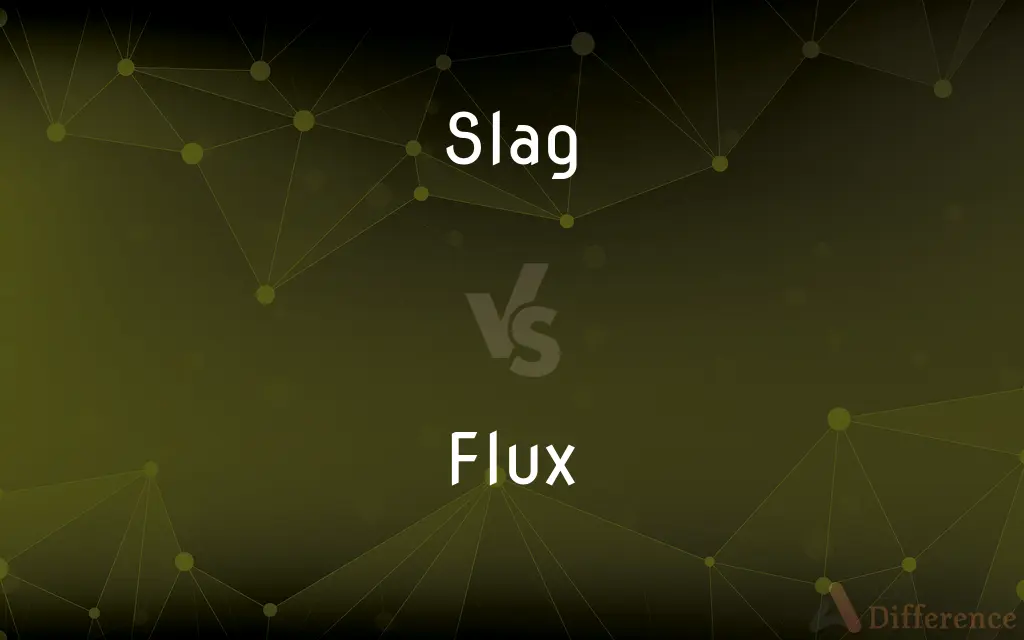Slag vs. Flux — What's the Difference?
By Maham Liaqat & Fiza Rafique — Updated on April 2, 2024
Slag is a byproduct of metal smelting, containing impurities and waste, whereas flux is a substance added to aid in the purification process during smelting.

Difference Between Slag and Flux
Table of Contents
ADVERTISEMENT
Key Differences
Slag is formed during the metal smelting process as a layer on the surface of the molten metal, comprised of impurities, waste materials, and metals that are not the target of extraction. On the other hand, flux is introduced to the smelting process intentionally, designed to bind with impurities and facilitate their removal, forming slag.
The primary purpose of slag is to collect the non-metallic impurities that are present in the ore or that form as a result of the smelting process. Whereas, the role of flux is to lower the melting point of these impurities, making it easier to separate them from the metal.
Slag, as a byproduct, often needs to be disposed of or recycled, depending on its composition and the environmental standards. Flux, in contrast, is a crucial component of the smelting process, chosen specifically to match the type of ore being processed and the impurities that need to be removed.
While slag can sometimes find uses in construction or as a base material for roads, indicating a potential for recycling, flux is consumed during the smelting process and plays no further role once it has facilitated the removal of impurities.
Despite their contrasting roles, both slag and flux are essential to the metallurgical process, with slag serving as a repository for removed impurities and flux ensuring the efficiency of their removal.
ADVERTISEMENT
Comparison Chart
Definition
Byproduct of the metal smelting process, containing impurities and waste.
Substance added to smelting to aid in purifying the metal by lowering impurities' melting points.
Purpose
Collects and removes impurities from the molten metal.
Facilitates the removal of impurities by making them easier to separate.
Composition
Comprised of impurities, waste materials, and sometimes metals not targeted for extraction.
Specifically chosen substances that react with impurities to form slag.
Aftermath
Often needs to be disposed of or can be recycled depending on its properties.
Consumed during the smelting process and plays no further role afterward.
Uses
Can be used in construction, road bases, or as a raw material for other processes.
Specifically used to improve the efficiency and cleanliness of metal smelting processes.
Compare with Definitions
Slag
Formed at the surface of molten metal.
As the smelting process continued, a thick layer of slag formed atop the metal.
Flux
Enhances smelting process.
Flux addition is a critical step in achieving high-quality steel in the furnace.
Slag
Contains metal impurities.
Slag is analyzed to recover any valuable metals that might be present.
Flux
Substance added to purify metals.
They added limestone as flux to remove impurities from the iron.
Slag
Waste byproduct of smelting.
The slag from the furnace was cooled and then used for road construction.
Flux
Chosen based on ore type.
Selecting the right flux is essential for the successful extraction of metals from different ores.
Slag
Can have environmental impact.
Proper slag management is crucial to minimize its environmental footprint.
Flux
Lowers melting point of impurities.
The flux made it easier to separate the waste from the copper during smelting.
Slag
Requires disposal or recycling.
The company has developed a method for recycling slag into useful construction materials.
Flux
Consumed during smelting.
A precise quantity of flux is necessary for each batch of metal to ensure efficiency.
Slag
Slag is the glass-like by-product left over after a desired metal has been separated (i.e., smelted) from its raw ore. Slag is usually a mixture of metal oxides and silicon dioxide.
Flux
Flux describes any effect that appears to pass or travel (whether it actually moves or not) through a surface or substance. A flux is a concept in applied mathematics and vector calculus which has many applications to physics.
Slag
The vitreous mass left as a residue by the smelting of metallic ore.
Flux
The action or process of flowing or flowing out
The flux of ions across the membrane
Slag
See scoria.
Flux
An abnormal discharge of blood or other matter from or within the body.
Slag
To change into or form slag.
Flux
Continuous change
Since the fall of the wall Berlin has been a city in flux
The whole political system is in a state of flux
Slag
Waste material from a mine.
Flux
A substance mixed with a solid to lower its melting point, used especially in soldering and brazing metals or to promote vitrification in glass or ceramics.
Slag
Scum that forms on the surface of molten metal.
Flux
Treat (a metal object) with a flux to promote melting.
Slag
Impurities formed and separated out when a metal is smelted from ore; vitrified cinders.
Flux
A flow or flowing of a liquid.
Slag
Hard aggregate remaining as a residue from blast furnaces, sometimes used as a surfacing material.
Flux
The flowing in of the tide.
Slag
Scoria associated with a volcano.
Flux
A continuing movement, especially in large numbers of things
A flux of sensation.
Slag
A coward.
Flux
Constant or frequent change; fluctuation
"The constant flux of people and groups ensures that human gene pools will always be mixed" (Steve Olson).
Slag
A contemptible person, a scumbag.
Flux
(Medicine) The discharge of large quantities of fluid material from the body, especially the discharge of watery feces from the intestines.
Slag
A prostitute, or a woman who acts like one; a slut.
Flux
The rate of flow of fluid, particles, or energy through a given surface.
Slag
(transitive) To produce slag.
Flux
See flux density.
Slag
(intransitive) To become slag; to agglomerate when heated below the fusion point.
Flux
The lines of force of an electric or magnetic field.
Slag
(transitive) To reduce to slag.
Flux
A substance applied to a surface to be joined by welding, soldering, or brazing to facilitate the flowing of solder and prevent formation of oxides.
Slag
To talk badly about; to malign or denigrate (someone).
Flux
A mineral added to the metals in a furnace to promote fusing or to prevent the formation of oxides.
Slag
To spit.
Flux
An additive that improves the flow of plastics during fabrication.
Slag
The dross, or recrement, of a metal; also, vitrified cinders.
Flux
A readily fusible glass or enamel used as a base in ceramic work.
Slag
The scoria of a volcano.
Flux
To melt; fuse.
Slag
A product of smelting, containing, mostly as silicates, the substances not sought to be produced as matte or metal, and having a lower specific gravity than the latter; - called also, esp. in iron smelting, cinder. The slag of iron blast furnaces is essentially silicate of calcium, magnesium, and aluminium; that of lead and copper smelting furnaces contains iron.
Flux
To apply a flux to.
Slag
To form, or form into, a slag; to agglomerate when heated below the fusion point.
Flux
To become fluid.
Slag
The scum formed by oxidation at the surface of molten metals
Flux
To flow; stream.
Flux
The act of flowing; a continuous moving on or passing by, as of a flowing stream.
Flux
A state of ongoing change.
The schedule is in flux at the moment.
Languages, like our bodies, are in a continual flux.
Flux
A chemical agent for cleaning metal prior to soldering or welding.
It is important to use flux when soldering or oxides on the metal will prevent a good bond.
Flux
(physics) The rate of transfer of energy (or another physical quantity), especially an electric or magnetic field, through a given surface.
That high a neutron flux would be lethal in seconds.
Flux
(archaic) A disease which causes diarrhea, especially dysentery.
Flux
(archaic) Diarrhea or other fluid discharge from the body.
Flux
The state of being liquid through heat; fusion.
Flux
(transitive) To use flux on.
You have to flux the joint before soldering.
Flux
(transitive) To melt.
Flux
(intransitive) To flow as a liquid.
Flux
(uncommon) Flowing; unstable; inconstant; variable.
Flux
The act of flowing; a continuous moving on or passing by, as of a flowing stream; constant succession; change.
By the perpetual flux of the liquids, a great part of them is thrown out of the body.
Her image has escaped the flux of things,And that same infant beauty that she woreIs fixed upon her now forevermore.
Languages, like our bodies, are in a continual flux.
Flux
The setting in of the tide toward the shore, - the ebb being called the reflux.
Flux
The state of being liquid through heat; fusion.
Flux
Any substance or mixture used to promote the fusion of metals or minerals, as alkalies, borax, lime, fluorite.
Flux
A fluid discharge from the bowels or other part; especially, an excessive and morbid discharge; as, the bloody flux or dysentery. See Bloody flux.
Flux
The quantity of a fluid that crosses a unit area of a given surface in a unit of time.
Flux
Flowing; unstable; inconstant; variable.
The flux nature of all things here.
Flux
To affect, or bring to a certain state, by flux.
He might fashionably and genteelly . . . have been dueled orfluxed into another world.
Flux
To cause to become fluid; to fuse.
Flux
To cause a discharge from; to purge.
Flux
The rate of flow of energy or particles across a given surface
Flux
A flow or discharge
Flux
A substance added to molten metals to bond with impurities that can then be readily removed
Flux
Excessive discharge of liquid from a cavity or organ (as in watery diarrhea)
Flux
A state of uncertainty about what should be done (usually following some important event) preceding the establishment of a new direction of action;
The flux following the death of the emperor
Flux
The lines of force surrounding a permanent magnet or a moving charged particle
Flux
(physics) the number of flux changes per unit area
Flux
In constant change;
His opinions are in flux
The newness and flux of the computer industry
Flux
Move or progress freely as if in a stream;
The crowd flowed out of the stadium
Flux
Become liquid or fluid when heated;
The frozen fat liquefied
Flux
Mix together different elements;
The colors blend well
Common Curiosities
What happens to flux after the smelting process?
After the smelting process, flux is consumed and becomes part of the slag, playing no further role.
What is the purpose of flux in metal smelting?
Flux is added to the smelting process to lower the melting points of impurities, facilitating their separation and removal from the metal.
What is slag?
Slag is a byproduct of the smelting process, comprising primarily of impurities and waste materials separated from the metal.
Can slag be recycled?
Yes, slag can sometimes be recycled and used in construction, road-making, or as a raw material in other industrial processes.
What are common materials used as flux?
Limestone, silica, and borax are common materials used as flux, depending on the metal being smelted and the impurities present.
Can slag be completely eliminated from the smelting process?
Slag cannot be completely eliminated, as it is a necessary byproduct of separating impurities from the metal.
Why is proper management of slag important?
Proper management of slag is important to minimize its environmental impact and to explore opportunities for its recycling and reuse.
Is the composition of slag always the same?
The composition of slag varies depending on the type of metal being smelted and the specific impurities present in the ore.
How is flux chosen for a smelting process?
Flux is chosen based on the type of ore being processed and the specific impurities that need to be removed.
How does flux improve the smelting process?
By lowering the melting points of impurities and facilitating their removal, flux makes the smelting process more efficient and improves the quality of the metal produced.
Is slag harmful to the environment?
Slag can have environmental impacts if not properly managed, due to the heavy metals and other pollutants it may contain.
What role does slag play in the circular economy?
In the circular economy, slag can play a significant role by being recycled and used as a raw material in various industries, thereby reducing waste and conserving resources.
How does the presence of flux affect the quality of the metal produced?
Flux helps produce higher-quality metal by ensuring that impurities are efficiently removed during the smelting process.
How can flux consumption be optimized in smelting?
Flux consumption can be optimized by carefully calculating the amount needed based on the ore composition and desired metal purity.
What are the environmental considerations for disposing of slag?
Disposing of slag involves ensuring that it does not leach harmful chemicals into the environment and finding ways to recycle or repurpose it when possible.
Share Your Discovery

Previous Comparison
Sextant vs. Astrolabe
Next Comparison
Colourful vs. ColorfulAuthor Spotlight
Written by
Maham LiaqatCo-written by
Fiza RafiqueFiza Rafique is a skilled content writer at AskDifference.com, where she meticulously refines and enhances written pieces. Drawing from her vast editorial expertise, Fiza ensures clarity, accuracy, and precision in every article. Passionate about language, she continually seeks to elevate the quality of content for readers worldwide.














































